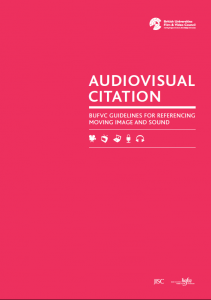 Il British University Film & Video Counsil (BUFVC) ha pubblicato on line, scaricabile in pdf (riportato in calce anche al presente post): “Audiovisual Citation - BUFVC Guidelines for referencing moving image and sound”. Come scritto in un bell’articolo on line: Citing Films, Television and Audio in your Content – Could it be Easier?, sul sito di EUScreen: “In the era of YouTube, podcasts and vidcasts new pioneering guidelines, launched today, will be crucial for students, researchers and academics when they cite moving image and sound sources, or provide advice on referencing them.”
Il British University Film & Video Counsil (BUFVC) ha pubblicato on line, scaricabile in pdf (riportato in calce anche al presente post): “Audiovisual Citation - BUFVC Guidelines for referencing moving image and sound”. Come scritto in un bell’articolo on line: Citing Films, Television and Audio in your Content – Could it be Easier?, sul sito di EUScreen: “In the era of YouTube, podcasts and vidcasts new pioneering guidelines, launched today, will be crucial for students, researchers and academics when they cite moving image and sound sources, or provide advice on referencing them.”
Si tratta di pionieristiche linee guida per aiutare a rispondere a tutte le domande relative a come far riferimento e a come citare le immagini in movimento (film, audiovisivi, programmi televisivi, video on line su youtube etc.), nonché i documenti sonori. Uno strumento fondamentale per studiosi, studenti, ricercatori e docenti universitari, …
La guida, divisa in capitoli per tipologia di media e ambiente, fornisce numerosi, dettagliati esempi di citazioni (finalmente normalizzate), con appendici a glossari specifici (tipologia di documento, autori, formati).
Da tenere sempre a portata di “clic”! Si potrebbe ipotizzare una traduzione in italiano, ma gli esempi sono davvero di facile lettura e applicazione.
BUFVC- Audiovisual Citation Guidelines
NOTA BENE: “This is the first edition of the guidelines and it will be reviewed periodically. The BUFVC welcomes comments and feedback via email, or join the discussion by tweeting @bufvc.”







